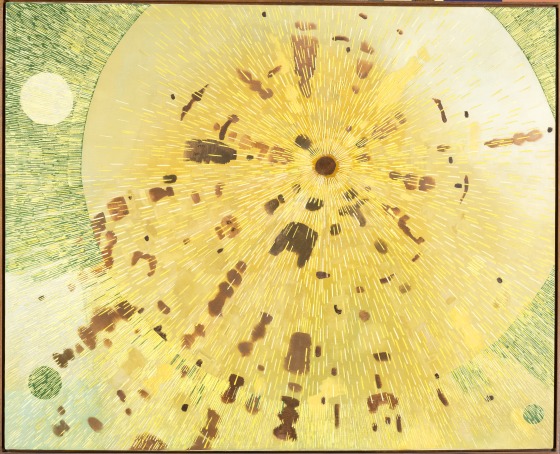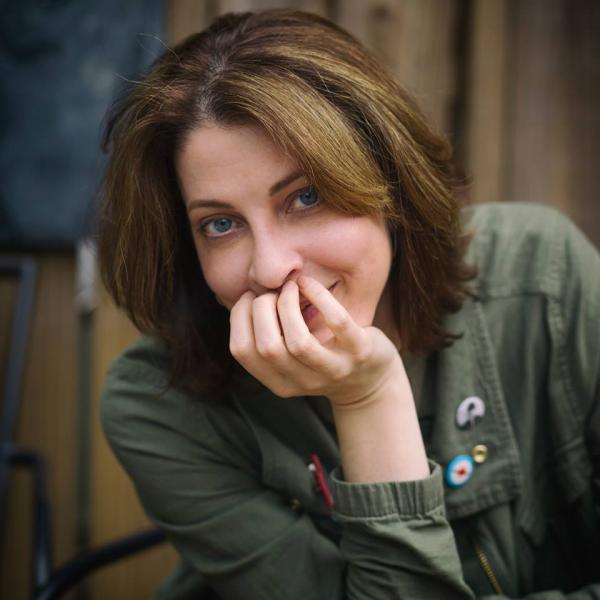Unframed is taking a look behind the scenes to profile the creative, dedicated people who make LACMA special. We sat down with senior editor Sara Cody to talk about her path to LACMA, her creative outlet, and her favorite exhibition.
What do you do at LACMA?
I am a senior editor in the publications department, and that means I primarily work on the exhibition catalogues. I really love the big picture of bringing together a whole project. My dad’s an artist and I grew up as a total bookworm, so there could not have been a better job. It’s one of those jobs that’s inherently rewarding because there’s a physical product at the end of it that is beautiful. An art book has a lasting impact beyond a particular exhibition or the walls of this museum. It’s something that goes out there in the world. It’s really rewarding.
What was your path to LACMA?
I started as a freelancer. I grew up in Colorado and Wyoming but I was living in Chicago before I moved out here and did a little bit of everything [in terms of] editing and writing. Business editing, mostly. I did a lot of political activism. I did a lot of music criticism. And so I moved out here for various reasons and got this freelance [position] here. It wasn’t even really an editorial job. It was a research job specifically on a project out of the Rifkind Center for German Expressionism. Tim Benson is the curator. And he was doing this fantastic two-book set on central European avant garde movements of the 1910s and the 1920s. I walked into the Rifkind Center and my knees kind of buckled a little. I was like—oh, it’s heaven! It’s this beautiful library under the Bing Theater, with floor-to-ceiling bookcases, and prints and posters looking out onto the trees and I [thought], they’re going to have to drag me out of here. I decided to make myself totally indispensable on that project, so I immediately began behaving like the assistant editor. It must have been about nine months later that an associate editor job opened in publications. And they said do you want it? Yes, I do! And that is how I got here. That was fifteen years ago. I’ve never lived anywhere as long as I’ve lived in L.A.
Do you like L.A.?
I’m completely surprised that I ended up here and that I ended up loving it as much as I did. I was always one of those people who was kind of snotty about L.A. And then I was here visiting my sister, flying out from a Chicago winter to L.A. in January. I moved here six or eight months later. I think, for me, having grown up in the West, there’s something about the West. There’s just something about the geography, the culture and society, and the way people interact. But it was weird coming back. I [realized], oh yeah, I’m actually from the West and I’m at home in the West. And I was instantly at home here.

What’s your favorite artwork in the collection and why?
One is a painting by Lee Mullican called Space. It’s painted around the early ’50s. Speaking of the West Coast, Lee Mullican was part of a really interesting West Coast mid-century abstract group called the Dynaton group and they got no attention, because, of course, [everyone’s watching] East Coast abstract expressionism. People couldn’t even be bothered to think of L.A. as a real center of art. And what’s great is Mullican and those guys could develop in their own world a completely different approach to mid-century expressionism. And abstraction. It’s an exquisite painting. It’s exceedingly, timelessly spiritual but super modern in this beautiful, absolutely cool, mid-century way.
What is your creative outlet?
Right now I’m writing a novel, just finishing up the first draft right now. It’s set in Vienna, at the turn of the 19th to the 20th century. Klimt will actually be making a background appearance; there are a couple of artists that make a very background appearance. The woman I’m writing about, she was a historical figure. She was one of the royal mistresses for the Hapsburgs. There’s not a lot known about her—she was an actress and a dancer, which is usually code for a high-class prostitute. And in some records she’s an artist’s model, also code for prostitute. And so there’s going to be a few scenes in which she’s an artist’s model. So that’s what I do as my main creative outlet.
But then my other creative slash energy outlet is definitely music. I am an old school rocker girl freak. I go to concerts every chance I get, it’s a big deal to me. I’m also, in the wake of David Bowie’s death, working on a series of articles. So Bowie and thinking about Bowie has been a kind of creative outlet for me recently.
So you were a Denver punk?
There were a couple of different scenes in Denver. I wasn’t in the hardcore scene. I was more in the alternative scene. It was fun. We got to see a lot of great bands.
I think there’s so much that comes out of punk as an ethos in terms of how you live your life and how you approach your life creatively. It is a bit of a cliché but it’s also very true that, at heart, punk is about do-it-yourself, back to basics, and it’s about trying to sabotage dominant narratives about consumerism and identity. There’s something profoundly, deeply creative about that. There’s a whole lineage with punk that goes back to Dada. I’m not the first to make that argument at all; that became an argument about punk several decades ago. Dada is reacting during WWI against the absurdity of the war, the absurdity of the crumbling of the European empires, and punk comes out of this too, in a postwar sense of punk reacting against the absurdities of the Cold War. I don’t think it’s an accident that they come down to a lot of similar techniques.
What is one of your favorite past exhibitions?
The most personally meaningful was Hans Richter: Encounters (2013). Richter started off as Expressionist but was there at the beginning of Dada. He is this character who shows up everywhere in art history. He is side-by-side with the Surrealists and the Dadaists and the Expressionists and the Bauhaus and the Constructivists. Name an important avant garde European artist of the 20th century—Hans Richter collaborated with them. So that show was extremely rewarding, looking at Richter in terms of his social interactions with other artists, because it cut against the idea of the artist as the tortured lone figure in a garret who only can create in isolation.
Richter did a lot of writing about Dada history and art theory. Toward the end of his life, in the ’60s, he had written a book that was published in Germany called Encounters from Dada till Today. It was all about these personal reminiscences of hanging around with Tristan Tzara, George Grosz, the biggies of modern art. His drinking buddies were the pillars of modernism. It had been translated into a manuscript into English by a poet named Christopher Middleton. Middleton does the translation and, because Richter was ill toward the end of his life, the publication never happened. The manuscript goes and sits in an archive, basically, for forty years. With the permission of the estate, we got to publish that translation. It was the first time it ever appeared in English. It’s such an enormously moving meditation on the creative impulse and how creativity gives your life meaning, but also how it’s meaningless—at least [Richter] would contend it was meaningless—without friendships. And without relationships. Those two books, the exhibition catalogue and [Encounters from Dada till Today], are definitely the most rewarding of my career.
The conversation was condensed and edited for clarity.



